Literature and Mathematics
Introduction
This page includes information to explore mathematics with literature. How literature can be used to explore, investigate, and facilitate the learning of mathematics. How to use mathematics to explore literature and examples of literature with suggestions on how different dimensions of mathematics can be related to math and facilitate literacy.
An investigation into how literature has been used in classrooms to teach mathematical topics found these eight ways:
Uses of literature to facilitate math literacy
Eight ways literature is used to facilitate the learning of mathematics, with examples and a brief explanation.
1. A mathematical problem is presented as part of the plot.
- The King's Chessboard The king wanted to pay a wise man for his help. The wise man was satisfied without payment, but the king insisted. The wise man asks for one grain of rice, and then double that amount for each square on a checkerboard. The king begins to pay and learns a lesson about pride.
- Pigs will be Pigs A family of pigs is out of food so they search their home for money. They collect a variety of money. How much do they have, can they eat out, and how much change will they get back?
- Ten Pennies for Candy A child has the problem of wondering what candy is affordable with ten pennies for a group of friends. A solution is modeled in the book.
2. Stimulate mathematical exploration.
- Alexander Who Used to Be Rich Last Sunday Make a chart of where the money went.
- Twelve Days of Christmas Explore the use of patterns, charts, diagrams, and pictures to solve problems. How many presents.
- Thirteen Days of Halloween Explore the use of patterns, charts, diagrams, and pictures to find how many presents. Figure probability of randomly choosing one of the many present.
3. Model a mathematical creative experience.
- Anno's Counting Book Use to model counting or creating counting books.
- Sweet Clara and the Freedom Quilt Model making a quilt.
- Jumping the Broom Model making a star quilt block.
4. Relate mathematics to a theme of study.
- The Hundred Penny Box Theme to money.
- The Great Kapok Tree: A Tale of the Amazon Rain Forest Draw a scale diagram of a rain forest to include plants' and animals' relative sizes.
- Is a Blue Whale the Biggest Thing there is? Large numbers of the Universe
5. Use to introduce a mathematical activity.
- More Spaghetti I Say! (1977) Introduce sorting, counting, classification of pasta.
- The Hundred Penny Box Introduce a one hundred chart and hundred chart activities.
- Stay in Line Number sense, value of numbers
6. Use to create mathematical problems related to the text
- Moira's Birthday Introduce a study of what would be needed for a party if you invited everyone in your school K - 6.
- The Hundred Penny Box Introduce problem of what dates are more likely to be found in a collection of 100 pennies.
- A quarter from the Tooth Fairy Models ways to make twenty - five cents. Students could create other ways to make a quarter and other values of money.
7. Provide mathematical knowledge about the world.
- Biggest, Strongest, Fastest Provides information about several different animals.
8. Provide a context for mathematical assessment.
- Each Orange Slice Had 8 Slices Use to assess addition, and multiplication concepts
Ways to mathematize literature
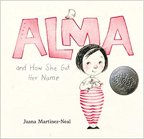
- Make predictions
- How to use math to make predictions. Size, distance, time ... How far did the character travel? How long did the person wait? How many is ...?
- Alma and How she Got her Name by Martinez-Neal (2018) Alma is concerned about writing her name on her school papers. Which causes one to predict her full name is longer than her four letter first name, Alma.
- Create another outcome.
- Shel Silverstein's poem Smart. About a boy who swaps money. Starting with a dollar bill, which he swaps for two quarters, because two is more than one. What other swaps could have been made? What accurate swaps might have been made?
- How could a plot be changed? What mathematical values can be used to represent a change? What pivotal moment is best for the change? How will the change affect the story?
- Find unknown values
- In any of the three little pig stories, how big were the houses? How many rooms? How many sticks or bricks? How big is the wolf? How big is the fire or kettle or ... Why is there often three?
- Mathemetize the action
- Identify quantities or measurements or ideas which are repeated and can be quantified or represented mathematically. Represent them as, patterns, sentences, equations, functions, diagrams, charts, ...
- Be creative with quantities
- Take ideas which may not exactly be mathematical and push mathematical ideas into them.
Literature books with mathematical themes
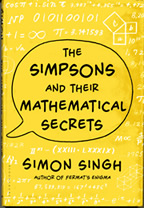
The Simpsons and their Mathematical Secrets - 2014, Bloomsberry: New York. pages 213 ages 12+.
ISBN-13: 978-1-62040-277-1.
Excellent story for anyone that is a fan of the Simpsons, interested in mathematical ideas, trivia nut, Futurama fan, or people interested in behind the scene stories.
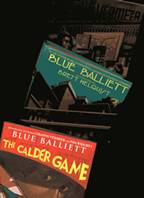
Chasing Vermeer - 2004, The Wright 3 - 2006, The Calder Game - 2008. ages 10-14.
ISBN-10: 0-325-00353-x.
Excellent realistic fiction mystery with themes of art, architecture, friendship, and pentominoes.
See also Chasing Vermeer - A new character, Tommy, joins Petra and Calder for three adventures in urban Chicago. Includes logic, mystery, and Pentominoes go 3-D, many math themes, great read for intermediate, middle school, and others.
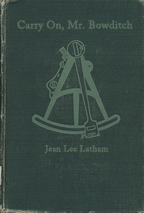
Carry on, Mr. Bowditch - 1955, Houghton Mifflin Company: Boston. pages. middle level.
ISBN- .
Excellent historical fiction about navigation.
Nathaniel Bowditch, a real life navigator, grew up in Salem, MA when tall-masted ships were the transportation marvels of the day. However, to navigate safely from port to port a sailor needed to know mathematics, astronomy, and cartography. Along with this knowledge they used log, lead, and lookout to navigate the ocean. The plot describes Nat's years of study, observation, and writings that resulted in his successful voyages and publishing of his famous work, The American Practical Navigator (the Sailors' Bible) that was used for many years by navigators. A true New England hero.
Newbery medal winner.
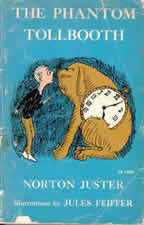
The Phantom Tollbooth. - 1961. middle level.
ISBN- .
Excellent use of language. Problem solving, philosophy, boredom, learning, imagination, and the realities of the loss of rhyme and reason.
Main character: Milo
Plot: Milo is bored and returns home to find a magic tollbooth in his room. He jumps in his toy car and enters the Lands Beyond. Where he discovers two brothers, King Azaz of Dictionopolis and the Mathemagician of Digitopolis exiled their sisters, Rhyme and Reason. Which supposedly makes the Lands Beyond more strange. Milo decides it should be his mission to rescue these ladies. Why not?
Newbery medal winner.
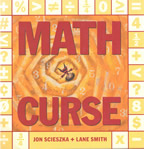
The Math Curse. - 1995. New York: Viking, middle level.
ISBN- 0670861944.
Problem solving, perspective of mathematics.
Plot - mathematics is everywhere.
While this is a picture book, a certain amount of sophistication is required to appreciate the theme. Excellent
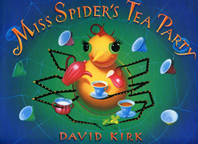
Miss Spider's Tea Party - 1994, . pages 32. primary.
ISBN-10: 0590477242.
Miss Spider wants her insect friends to come over for tea, but each one turns down her invitation for fear she'll eat them. When Miss Spider comes to the aid of a wet moth, word spreads of her good nature, and their perspective changes.
Different sets of 1-12 insects arrive for tea.
Themes: Number value, counting, spiders, party, insects, picture book.

The Doorbell Rang - 1986. Greenwillow Books: New York. primary.
ISBN- 0-688-09234-9.
Sharing 12 cookies 6 ways.
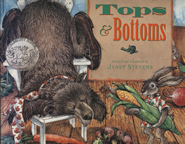
Tops and Bottoms - 1995. Scholastic: New York. primary.
ISBN- 0-590-97550-1
Trickster, lazy/worker. Problem solving, tops, bottom, middles.
Prereading - Ask. What are the ways of dividing crops without numbers?
Read book, stop and discuss, ask for plot predictions ...
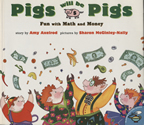
Pigs Will Be Pigs - 1994. Four Winds Press: New York. 32 pages.
ISBN- 0-689-81219-1.
A family of pigs wants to go out to eat, but their purses and wallets are empty so they go on a money hunt. How much did they find? What could they spend? How much did they have left after dinner? 7 F
12 Ways To Get To 11 - 1993. Trumpet New York. primary ages .
ISBN- 0-440-83115-6.
Sums of 11
Literature suggestions by math dimensions
Number value
Order, classification
- Strongest, Fastest. Jenkins, Steve Ticknor & Fields Books for Young Readers New York 1995 0 - 395 - 86136 - 5 Animal records of size, speed… 8 P,NF
- Blue Sea. Kalan, Robert Il. Donald Crews Trumpet Club New York 1979 0 - 440 - 84979 - 9 Big, bigger, biggest, little, littler, littlest 5 F
- Color Farm. Ehlert, Lois Trumpet Club New York 1990 0 - 440 - 84709 - 5 Shape, color, animals 5 C
- Geraldine’s Blanket. Keller, Holly Greenwillow Books New York 1984 0 - 688 - 07810 - 9 Getting smaller, whole to part 5 F
- Opposites. Kightley, Rosalinda Trumpet New York 1986 0 - 590 - 06218 - 2 Opposites 5 P
- The Best Bug Parade. Murphy, Stuart J. Illus. Holly Keller Scholastic New York 1997 0 - 590 - 06263 - 8 Big, bigger, biggest; Small…; long… short…; good, better, best 6 C
- The Story of Z. Modesitt, Jeanne Illus. Lonni Sue Johnson Saxonville, Mass.:Picture Book Studios 1990. Order, last, Z goes on strike and bedlam follows till Z is coaxed back.
- The Wuggie Norple Story. Pinkwater, Daniel M. Illus. Tomie de Paola Trumpet Club New York 1980 0 - 440 - 84879 - 2 Relative size, bigger, smaller, same 5 P
- Which Witch is Which? Hutchins, Pat Greenwillow Books New York 1989 Can you tell which twin is which? 7 F
Counting
- From One to One Hundred. Sloat, Teri Puffin Books New York 1991 0 - 14 - 055643 - 5 Counting book from 1,2,3 - 10,20,30 - 100 6 F
- Counting on Frank. Clement, Rod Gareth Stevens Children’s Books Milwaukee, WI 1991.
- One Hundred Hungry Ants. Princzes, Elinor J Houghton Mifflin Co. Boston 1993 How fast to picnic in lines of 1, 2, …10 7 F
- Ten Black Dots. Crews, Donald Scholastic New York 1986 0 - 590 - 46479 - 5 Number value to 10 1 - 1 correspondence, symbols 5 C
- Ten For Dinner. Bogart, Jo Ellen Scholastic Books New York 1989
- The 100th Day of School. Medearis, Angela Shelf Il. Joan Holub Scholastic New York 1996 0 - 590 - 25944 - X Number value 100 6 C
- One, Two, One Pair. McMillan, Bruce Scholastic New York 1991 0 - 590 - 43798 - 2 Number value 1, 2, pair 5 P
- There's a Hole in My Pocket Gibson, Akimi Illus. Jeni Bassett Scholastic New York 1994 0 - 590 - 27598 - 4 Number value, zero 6 C
- Thirteen Days of Halloween. Greene, Carol Children’s Press Chicago 1983 Three Pigs,
- Twelve Ways to Get to Eleven. Merriam, Eve Illus. By Bernie Karlin Simon & Schuster New York 1993
- Two Tiny Mice Baker, Alan Scholastic New York 1990 0 - 590 - 46404 - 3 Visualization, number value 2 and relative size 5 P
- How Many Snails. Giganti 1988
- More than One. Hoban 1981
- The 329th Friend. Sharmat 1979. Emery Raccoon has a party, invites 328 forest guests, but Emery is disappointed with all the commotion, leaves, and learns he is a friend of himself. Then some guests notice him, thank him, and invite him to visit. Number value 329. What is an optimum number of party guests?
- How to Count like a Martian. St. John 1975. Counting systems include: ancient Egyptians, Babylonians, Mayans, Greeks, and Hindus, describes the operation of an abacus and a computer, and an imaginary Martian system. Middle level
- The King’s Commissioners. Friedman 1994. counting and place value.
- Cookies. Jaspersohn 1993
- 8,000 Stones Wolkstein 1972
- How to Count like a Martian. (picture book) St. John 1975. Counting systems include: ancient Egyptians, Babylonians, Mayans, Greeks, and Hindus, describes the operation of an abacus and a computer, and an imaginary Martian system. Middle level.
Counting money & change
- 26 Letters and 99 Cents. Tana Hoban, Scholastic: New York. 1987. Primary. 0-590-41831 9 Combinations of coins to .99
- A Quarter From the Tooth Fairy. Holtzman, Caren Illus. By Betsy Day Scholastic New York 1995 0 - 590 - 36598 - 9 Quarter and equivalent coins 6 F
- Benny’s Pennies. Brisson, Pat Bantam Doubleday New York 1993 0 - 440 - 41016 - 9 Shops buys five objects for family 5 F Biggest, equality,
- Pigs Will Be Pigs. Axelrod, Amy Four Winds Press New York 1994 0 - 689 - 81219 - 1 Money hunt, how much did they find and what did they have left after dinner? 7 F
Fractions
- Each Orange Had 8 Slices. Giganti, Paul Jr. Il. Donald Crews Trumpet Club New York 1992 0 - 440 - 84957 - 8 Number value, skip counting, multiples, addition, problem solving 7 + P
- Eating Fractions. McMillan, Bruce Scholastic New York 1991 0 - 590 - 43771 - 2 Whole, halves, thirds, & fourths 6 C
- Fraction Action. by Leedy, Loreen Trumpet Club New York 1994 0 - 440 - 83436 - 8 fractional parts as equal shares, and parts of a whole 7 C
Really large numbers
- A Million Fish… More or Less. McKissack, Patricia C. Il. Dena Schutzer Trumpet New York 1992 0 - 440 - 83063 - X Tall tale, number value, estimation 7 F
- G is for Googol: A Math Alphabet Book. Schwartz, David Illus Marissa Moss Scholastic Inc. New York 1998 0 - 439 - 10489 - 0 Informational book 10 NF
- How Much is a Million. Schwartz, Davie M. Il. Steven Kellogg Scholastic New York 1985 0 - 590 - 43614 - 7 Number value 1,000,000 6 P
- If You Made a Million. Schwartz, David M. Illus. Steven Kellogg Scholastic New York 1989 0 - 590 - 43608 - 2 Number value, money, 1,000,000 8 P
Operations
Groups
- Shoes, Shoes, Shoes. Morris, Ann Lothrop, Lee & Shepard Books New York 1995 28 Illustrations shoes from around world 6 P
- A Dozen Dozens. Harriet Ziefert Il. Chris Demarest Viking New York 1998 0 - 14 - 038819 - 2 Number value, dozen, _ dozen 5 C
- What Comes in 2's, 3's, & 4's? Aker, Suzanne Illus. Bernie Karlin Scholastic New York 1990 0 - 590 - 47838 - 9 Number value 2, 3, 4 PT F
- Anno’s Magic Seeds. Anno, Mitsumasa Philomel Books New York 1995 0 - 399 - 22538 - 2 Double, + , - 7 P
- A Remainder of One. Pinczes, Elinor J. Il. Bonnie Mackain Houghton Mifflin Company Boston 1995 0 - 395 - 69455 - 8 Division, matrix multiplication 7 P
- Moira's Birthday. Munsch, Robert Illus. Michael Martchenko Annick Press LTD Toronto, Canada 1987 0 - 920303 - 83 - 8 Birthday party for 200 6 F
- Stay in Line. Slater, Teddy Illus. Gioia Fiammenghi Scholastic New York 1996 0 - 590 - 22713 - 0 Field trip 12 students in different groups, patterns 6 F
- Gator Pie. Mathews 1979. Two gators find a pie and share as others come along. Sharing... fractions
- Anna’s Mysterious Multiplying Jar Anno & Anno 1983
Measurement
- How Big Is A Foot?. Myller, Rolf Illus. Rolf Mylier Dell Publishing New York 1990 Standard unit of measurement 6 F
- Inch by Inch. Lionni, Leo Scholastic New York 1960 0 - 590 - 47991 - 1 Measurement, inch 6 C
- Is a Blue Whale the Biggest Thing there is?. Wells, Robert E. Scholastic New York 1993 0 - 590 - 48471 - 0 Size of the Universe, really big numbers 9 P
- The Popcorn Book. De Paola, Tomie Holiday House New York 1978 0 - 590 - 40264 - 1 History of popcorn, measurement volume, 7 F
- The Principal’s New Clothes. Calmenson, Stephanie Scholastic New York 1989 Measurement 5 F
- Jim and the Beanstalk Briggs 1970. Measurement, problem solving.
- How big? How fast? How Hungry?. Waverly 1990
- In One Day Parker 1984. Time
Geometry
- Jumping the Broom. Wright, Courtni C. Holiday House New York 1994 0 - 8234 - 1042 - 0 Quilt patterns 8 F
- Sweet Clara and the Freedom Quilt. Hopkinson, Deborah Illus. By James Ransome Alfred A. Knopf New York 1993 0 - 679 - 87472 - 0 Spatial relationships, number value, patterns 8 HF
- The Greedy Triangle. Burns, Marilyn Illus. By Gordon Silveria Scholastic New York 1994.
- The Patchwork Quilt. Flournoy, Valerie Scholastic or Dial New York 1985 0 - 590 - 89753 - 5 patterns, History of families, black experience 6 F
Algebra
- Anno's Math Games II. Anno, Mitsumasa Philomel Books New York 1989 0 - 399 - 21615 - 4 Function, measurement, patterns 10 P
- The King’s Chessboard. Birch, David Illus. By Devis Grebu Dial Books for Young Readers New York 1988 0 - 14 - 054880 - 7 Proud King gift of rice double every day for each square on checker board 10 F
- One Wolf, and Seven Magic Shapes. Maccarone, Grace Scholastic New York 1997 Retelling of 3 pigs with tangrams 8 F
- The Man Who Counted: A Collection of Mathematical Adventures. MalbaTahan 1993. A young man goes on a fantastical journey and solves problems with arithmetic and algebra. Readers will experiment with mathematical ideas.
- Pattern. Pluckrose 1988 from the Math Counts series
- More Sideways Arithmetic from Wayside School. Sachar, Louis Scholastic New York 1994 0 - 590 - 47762 - 5 Puzzles and problems 9 R
- Sideways Arithmetic from Wayside School. Sachar, Louis Scholastic New York 1989 0 - 590 - 42416 - 5 Puzzles and quizzes 9 R
Sample math lessons with literature books in Teaching Children Mathematics
| Book Reference | Journal Reference | Annotation |
|---|---|---|
| What Comes in 2's, 3's, and 4's? Aker, Suzanne. Illus. By Bernie Karlin. New York: Simon & Schuster, 1990 |
Teaching Children Mathematics: Volume 4, Number 3, November 1997 | Number Value Describes everyday objects that come in 2's, 3's, & 4's. Make your own list and add to it. Make a book. Continue with 5... (Article lists ideas for books like this) |
| Pigs Will Be Pigs. Axelrod, Amy. New York: Four Winds Press, 1994 |
Teaching Children Mathematics: Volume 4, Number 3, November 1997 | Number value, money, problem solving Family of pigs are hungry but ate everything in the house and mom didn't go to the bank. They go on a money hunt and collect enough to go out to dinner. Menu included. How much money did they have left. Answer in book. Make own problems. (Article lists ideas for books like this) |
| The King's Chessboard. Birch, David. Illus. By Devis Grebu. New York: Dial Books for Young Readers, 1988 |
Teaching Children Mathematics: Volume 4, Number 3, November 1997 | Number value, patterns, problem solving The king wanted to pay a wise man for his help. The wise man was satisfied without, but the king insisted. The wise man asks for one grain of rice, and then double that amount for each square on a checkerboard. The king begins to pay and learns a lesson about pride. Book solves problem. Doubling and halving problems. If won a million dollars and spent half each day how long would it last? (Article lists ideas for books like this) |
| Ten For Dinner. Bogart, Jo Ellen. New York: Scholastic Books, 1989 |
Teaching Children Mathematics: Volume 2, Number 3 November 1995 | Number value, communication, graphing Margo has a birthday party with nine guests and one little devil. Students were introduced to graphing, teacher read the book, discussed the party and the devilish child. Asked them to speculate what kind of information in the book they could graph. When guests arrived, hats they made, what they wore, presents they brought, games played, songs sung, and how children got home. (good article) |
| Franklin Plays The Game. Bourgeois, Paulette, and Brenda Clark. Toronto, Ontario: Kids Can Press, 1995 |
Teaching Children Mathematics: Volume 4, Number 1, September 1997 | Problem solving, more than one way to solve a problem Read Franklin stories and stopped where Franklin had a problem. Asked students to brainstorm how he could solve the problem. E.G. in this book his team mates are not good players and enjoy playing soccer for the fun of it. However, the problem they are to solve is how to score a goal. Students (grade1/2) brainstormed and webbed their solutions in - groups. The author claimed that students transferred the idea of solving problems more than one way from these activities to mathematics class. (Good article) |
| Benny's Pennies. Brisson, Pat. New York: Bantam Doubleday, 1993. |
Harris, Jacqueline, Interweaving Language and Mathematics Literacy through a Story. Teaching Children Mathematics: Volume 5, Number 9 May 1999 | Number value, communication, spatial
reasoning: Teacher has two of each five objects Benny bought on a tray and lets small groups of students (grade not given) look at the objects. Asks to close eyes and tell what saw. Asks or probes for ideas related to mathematics how many, how big, show with hands, shape, and other characteristics, color, materials. Then holds container and shakes. What is in it? Pennies. How many? Five. Is that right? Class answers yes. Tells she will read a story that has all the items. Asks to predict from cover. As read book asked numerous questions (see text for questioning strategies). Students worked in small groups to read and dramatize the story during the week. Later take home in book bag to share with parents. |
| T
he Greedy Triangle. Burns, Marilyn. Illus. By Gordon Silveria. New York: Scholastic, 1994 |
Teaching Children Mathematics: Volume 4, Number 3, November 1997 | Spatial reasoning, patterns Triangle is not happy being a triangle and adds one side at a time. How does the shape change? What happens to the number of vertexes as sides are added. What happens to the size of the angles as the sides are added? Draw the diagonals for each shape, is there a pattern? (Article lists ideas for books like this) |
| The Great Kapok Tree: A Tale of the Amazon Rain Forest. Cherry, Lynne. San Diego: Harcourt Brace & Co., 1990 |
Burton Gail Huge Trees, Small Drawings: Ideas of Relative Sizes. Teaching Children Mathematics: Volume 2, Number 8, November 1996 | Relative sizes, Number value, pattern, problem solving, relative size, proportion. Students (grade 6) made mural of rainforest and asked if animals/plants were the right size. Related size to classroom height and created a scale. Made terrariums and measured plants. Researched eating habits of some animals from the book and students wrote problems that they exchanged and discussed with others. |
| Dinner at the Panda Palace. Calmenson, Stepanie. New York: Harper Collins Publishers, 1991 |
Wickett, Maryann S., Serving Up Number Sense and Problem Solving: Dinner at the Panda Palace. Teaching Children Mathematics: Volume 3, Number 9 May 1997 | Number value, pattern, reasoning: Tell students (grade 3/4) to think about what questions you might ask by reading the book. Share book. Ask what questions would you like to answer? Students suggest. How many animals were at dinner? How many tables would you need if there were four at a table? Students picked how many animals. The teacher asks what materials will you need? Next the teacher asks how many feet? What materials will you need? Students are asked to share their answers and others are asked of their answers are reasonable. Later student asks, what is the right answer? Teacher asks how could the show an answer. Chart. Discuss how data and agree on results. |
| Get well gators!. Calmenson, Stephanie and Joanna Cole. New York: Marrow Junior Books, 1989 |
Wickett, Maryann S., Amanda Bean and the Gator Girls: Writing and Solving Multiplication Stories, Teaching Children Mathematics: Volume 6, Number 5, January 2000 | Multiplication Read Chapter 9 to students (grade 3). Amy and Allie plan to raise money to help repair the local playground by telling stories. For a fee the girls ask their customer to tell three facts and they created a story. Asked students to think of three facts about themselves, then write and solve a multiplication story using the three facts. Students could not, discuss what the problem was. Students had trouble connecting a number value to the facts and creating a problem. Some also had trouble with three and the teacher suggested two. Students wrote stories, solved, photocopied problems and created a class book for students to solve different problems. |
| The Principal's New Clothes. Calmenson, Stephanie. New York: Scholastic, 1989 |
Wickett, Maryann S., Measuring Up with The Principal's New Clothes. Teaching Children Mathematics: Volume 5, Number 8 April 1999 | Measurement linear and area: Read story and students (grade 4) suggest making clothes for our principal what would you need to measure so the clothes would fit. Divided students into groups, each group selected an adult in the school to make clothes. Students made three - dimensional models of their person out of paper. After having trouble making the models they decided to make half sized two - dimensional models of themselves and make flat clothes for their models. Measured in pairs with string and folded in half. When the models were finished they made clothes by measuring the model with conventional measuring tapes. Students hung their half - sized me up and reflected on what they learned. The half size is one fourth in area. To see cut a one size me, count the number of squares in it and the corresponding half size me and the area should be one - fourth or four times the other. |
| The Grouchy Ladybug. Carle, Eric, Hong Kong: Harper Trophy, 1977 |
Teaching Children Mathematics: Volume 4, Number 7, March 1998 | Number value pattern, clock, time The Grouchy Ladybug challenges a larger animal each hour until finally a whale swats the ladybug back to its original leaf. Tad the book and asked the students what the ladybug might have learned. Second reading asked them to watch for patterns and recorded ones the students identified. After students listed their ideas the teacher focused their attention on the clock patterns. Discussed patterns of clock. Passed out clocks to each pair of students, read book again, and had students move clock hands. When the ladybug is on the whale the students discuss if the pattern of one animal an hour is broken, since the ladybug talks to the whale every fifteen minutes. Asked students what it might be like if the whale was grouchy (a backwards story, or faster travel). Students created their own book. (Good article) |
| Counting on Frank. Clement, Rod. Milwaukee, Wisc.: Gareth Stevens Children's Books, 1991 |
Teaching Children Mathematics: Volume 4, Number 3, November 1997 | Measuring, problem solving Frank takes measuring and counting to the extreme. How many books it takes to fill the room? How many pencils you will use in a lifetime? How many students to fill the gym? Other questions? (Article lists ideas for books like this) |
| The Popcorn Book. De Paola, Tomie. New York: Holiday House, 1978 |
Hopokins, Linda, Popping Up Number Sense. Teaching Children Mathematics: Volume 2, Number 2, October 1995 | History of popcorn: |
| The Patchwork Quilt. Flournoy, Valerie. Illus. By Jerry Pinkney. New York: Dial Books For Young Readers, 1985. |
Smith, Jacquelin Threading Mathematics into Social Studies,. Teaching Children Mathematics: Volume 1, Number 7, March 1995 | Measurement, pattern, spatial reasoning, geometry, tessellation Students read the book and made their own four square quilt. Made a large square, cut into four smaller squares, manipulated to decide on a pattern for strips with no identical squares adjacent. Completed quilt and gave as a gift. |
| A Cloak for The Dreamer. Friedman, Aileen. New York: Scholastic Books, 1994 |
Teaching Children Mathematics: Volume 4, Number 9, May 1998 | Spatial reasoning, patterns, problem solving A tailor and three sons are asked to design and sew cloaks. Each cloak is made from a repeating pattern, rectangular like bricks on a floor, squares and triangles using the coat of arms colors, and the youngest son uses colors from nature and circles. The circle cloak has holes and is reworked, with help from father and brothers, to a warm cloak for world travel. Students (grade 5 - 6) listened to the story, posted diagrams of the cloaks, brainstormed how to fix the circle cloak, and finished the book. Students found that the circles were made into hexagons. They brainstormed how they might have made the cloak and what patterns they might have used. Students were asked to make their own cloak patterns. Did so with pattern blocks. When they were satisfied they sketched their design and wrote about them. The teacher asked them about the fractional parts of the different shapes and introduced vocabulary (slide, flip, turn, tessellation, tiling, and symmetry). (Very good article). |
| A Three Hat Day. Geringer, Laura. Illustrations by Arnold Lobel. Glenview, Ill.: Harper Collins Publishers, 1985 |
Teaching Children Mathematics: Volume 3, Number 7, March 1997 | |
| Thirteen Days of Halloween. Greene, Carol. Chicago: Children's Press, 1983 |
Teaching Children Mathematics: Volume 4, Number 2, October 1997 | Patterns, problem solving, probability Read the book First Day of Halloween (like first day of Christmas) to students (grade 3 - 4). Stopped after day four. Asked to describe the pattern and predict later days. After day five posed question. How many things did the witch receive on the fifth day? Asked to predict later days. Finished reading the book and students were asked to illustrate how many gifts the witch received on the twelfth day. Then moved to probability. She posed the problem of putting cubes into a box to represent each gift given on day twelve and asked what gift would most likely be drawn (what color cube)? Students predicted, created the model with Unifix cubes, drew 36 times, and graphed the results to get the experimental probability. They compared it to their theoretical probability. Next they were asked how to create a model and answer the same question if all the gifts given for all the days were put into a box and drawn randomly. (Very good article) |
| A Quarter From the Tooth Fairy. Holtzman, Caren. Illus. By Betsy Day. New York: Scholastic, 1995 |
Teaching Children Mathematics: Volume 4, Number 3, November 1997 | Number value, money A boy uses his quarter to buy stuff but keep returning them because he changes his mind. Each time he gets his money back a different way. Use coins to have students model the change. Have students model before reading and read the book as a summary. What can you buy for a quarter? What could your parents when they were your age? (Article lists ideas for books like this) |
| Sweet Clara and the Freedom Quilt. Hopkinson, Deborah. Illus. By James Ransome. New York: Alfred A. Knopf, 1993. |
Smith, Jacquelin Threading Mathematics into Social Studies,. Teaching Children Mathematics: Volume 1, Number 7, March 1995 | Number value, spatial reasoning, patterns, and map sequencing: Students review foursquare quilt block and designed a nine - square block. Discussed why this new pattern was a square. Predicted next larger squares. Made square blocks to 81. Asked how many square were added to one to make the next. Built squares by tessellation. Discussed how to insert the escape map. Colored on white fabric with fabric crayons, cut into squares the size of the nine - square patches, and ordered them into the pattern. Sewed strips... |
| The Doorbell Rang. Hutchins, Pat. New York: Greenwillow Books, 1986 |
Lubinski, Cheryl, A., & Otto, Albert D. Literature and Algebraic Reasoning. Teaching Children Mathematics: Volume 3, Number 6 February 1997 | Algebra, inverse relationship: Read the story to the students (grade 1). Asked what happened, created a two - column chart (number of children and number of cookies), then responded as the number of children got larger the number of cookies each received got smaller, and described their reasoning. Extended by asking what would happen if the 12 was increased to 24. Worked to help students see that as the number of people increased by 2 the amount of cookies was decreased by 1/2. By having students draw pictures, label, and explain reasoning the authors claim first grade students are able to understand the concept (see text). Next increased by three to show inverse relationship of three to 1/3. |
| Which Witch is Which? Hutchins, Pat. New York: Greenwillow Books, 1989 |
Leitze, Annette Ricks, Connecting Process Problem Solving to Children's Literature. Teaching Children Mathematics: Volume 3, Number 7, March 1997 | Problem Solving, reasoning: Read the book and discover which of the twin witches is Ella and which is Emily. Spin off problems How many cards did Mouse or mother writes if Mom could write twice as fast. Food problems, cleaning house problems. |
| Biggest, Strongest, Fastest. Jenkins, Steve, New York: Ticknor & Fields Books for Young Readers, 1995 |
Teaching Children Mathematics: Volume 3, Number 8 April 1997 | Number value, measurement, proportion, problem solving Shared book of facts of fourteen animals with her students (grade 3/4). Discussed the book. Asked students if they could use their height to measure some of the animals in the book to understand how big they really are. Since they were all different they needed to find an average height. Each student made a train of Unifix cubes that represented their height. Then the class lined them up and found the class average. Using the class average height how many students would it take to make different animals in the book? Students selected an animal, solved the problem, illustrated their answer, and shared their work with the rest of the class. (Very good article) |
| Geraldine's Blanket. Keller, Holly. New York: Greenwillow Books, 1984 |
Teaching Children Mathematics: Volume 1, Number 8 April 1995 | Number value, problem solving, addition, subtraction, place value, fractions, estimation Geraldine will not give up her blanket. Students shared stories of their special blanket or toy. Discussed how clever she was. This article discusses how the author created stories about patches on a blanket. Patches being added and different colored patches to assess her students' understanding of place value, addition, and subtraction. She also used wallpaper pieces (patches) and asked students to cover their desks. They had to cut some patches in half and discuss how students solved problems using estimation and fractions. (Good article) Could give students a sheet of paper or cloth (blanket) and smaller pieces (patches). Have the students see how many patches would fit on the blanket, Have students patch their blanket and write a problem. |
| Smoky: A Collection of Songs and Stories from Appalachia. Kidd, Ronald, comp. Nashville, Tenn.: Ideals Children' Books, 1992 |
Smith, Jacque, Assessing Children's Reasoning: It's an age - old Problem. Teaching Children Mathematics: Volume 2, Number 9, May 1996 | Reasoning, number sense, operations:
How old is she Billy Boy, Billy Boy
|
| Three Pigs, One Wolf, and Seven Magic Shapes. Maccarone, Grace. New York: Scholastic, 1997 |
Margerm, Pat An Old Tale with a New Turn and Flip and Slide. Teaching Children Mathematics: Volume 6, Number2 October 1999 | Spatial relations: Students (grade 4) retold Three Little Pigs from memory. As the teacher read the book she asked questions, introduced the tangram shapes, and made the figures in the book. Teacher used vocabulary to describe shapes and what she did with the pieces as she made some patterns (congruent, flip, slide, turn). Students created a cat with the paper pieces, glued them on paper, and wrote a description. Students were asked to decide what the two pigs that got married could do with the tangram pieces now that they had two houses. |
| Mirandy and Brother Wind. Mc Kissack, Patricia. New York: Scholastic, 1990 |
Teaching Children Mathematics: Volume 1, Number , March 1995 | |
| The M&M's Brand Chocolate Candies
Counting Book. McGrath, Barbara Barbieri. Watertown, Mass.: Charlesbridge Publishing, 1994 |
Teaching Children Mathematics: Volume 4, Number 3, November 1997 | Number value, patterns, problem solving Has many examples that use color, number, shapes, and sets. Use real or paper M&M's to make different arrangements. How many different arrangements can be made for two colors (how many ways can two M&M's be arranged in a row), three... (Article lists ideas for books like this) |
| Twelve Ways to Get to Eleven. Merriam, Eve. Illus. By Bernie Karlin. New York: Simon & Schuster, 1993 |
Teaching Children Mathematics: Volume 4, Number 3, November 1997 | Number value, patterns, communication,
charts Illustrates ways to get eleven. Draw a picture of your self. Sort the class pictures by different characteristics (hair color, gender...) and chart. Have students make books. (Article lists ideas for books like this) |
| The Story of Z. Modesitt, Jeanne. Illustrated by Lonni Sue Johnson. Saxonville, Mass.:Picture Book Studios, 1990 |
Teaching Children Mathematics: Volume 2, Number 4 December 1995 | Number value, pattern, estimation, charts Z feels disregarded and unloved because of lack of use, forms her own coalition of letters and leaves the English speaking world in a bind. She soon realizes the havoc she has caused and discovers it is not easy to lead a group of letters that all want to be first. Teacher read the book and asked the students if Z had a case. Students counted letters and graphed letters in their names. Students were asked to predict the use of letters before they made gelatin letters using alphabet cookie cutters. Students predicted it would follow the same pattern, but were surprised to find it did not. Students choose different letters. They discussed why. Answers included availability of cookie cutters. (Good article) |
| Shoes, Shoes, Shoes. Morris, Ann. New York: Published by Lothrop, Lee & Shepard Books, 1995 |
Teaching Children Mathematics: Volume 6, Number 4, December 1999 | Number value, measurement, estimation, problem solving Students (grade two with 7/8 grade facilitators) were asked to bring one of their Dad's shoes to school to make a father's day gift (if no father substitute uncle, grandfather, brother, friend). Students compiled a booklet "How Do You Measure a Dad?" Teacher read the book with 28 photographs from around the world and descriptions of each. Asked what did you notice about the shoes in this story? Students worked in small groups examining and brainstorming characteristics of the different shoes, (use, looks, parts, made, measurements), and sorted the shoes by categories, recorded their ideas, and shared ideas with the whole class. Next sorted their ideas by one category, then two, and made Venn diagrams. Measured the width and length with a variety of standard and non standard measures. Measured area by counting squares and measure mass. Data is recorded in the booklet, recorded on class graphs, and discussed. (Very good article) |
| Moira's Birthday. Munsch, Robert. Illustrated by Michael Martchenko. Toronto: Annick Press, 1987 |
Oppedal, Diane Cradick. Mathematics Is Something Good! Teaching Children Mathematics: Volume 2, Number 1 September 1995 | Number value, rate: Read book. Ask the students (grade 2) how can you show 200 things in different ways. Next day students shared their answers and reasoning. Asked if it took 200 children 10 minutes to eat 200 cakes, how long would it take them to eat 100 cakes, 20 cakes. |
| Something Good. Munsch, Robert. Illustrated by Michael Martchenko. Toronto: Annick Press, 1990 |
Oppedal, Diane Cradick. Mathematics Is Something Good! Teaching Children Mathematics: Volume 2, Number 1 September 1995 | Number value: Read book to students (grade 2). Told students that she knew that they could count 300 objects and challenged them to show it in a way that they could easily see what the value was and know it was accurate. Next had students figure how many squares fit on different areas (didn't seem logical to me). |
| How Big Is A Foot? Myller, Rolf. New York: Dell Publishings, 1990 |
Lubinski, Cheryl and Diane Thiessen, Exploring Measurement through Literature, Teaching Children Mathematics: Volume 2, Number 5, January 1996 | Measurement, standard unit: Read book to students (grade 1). Discussion based around teacher's questions. What are the problems in the story? Who had them? What solutions were presented? Is the chief carpenter's role important? How could the chief carpenter have solved the problem? What role did the apprentice play? Could the apprentice have asked the king questions to avoid the problem? Constructed paper foot prints and measured objects. Iteration problem. Linked footprints on strips of paper with the help of sixth grade students. Measured each other with each others foot ruler. Came to ask How bid was your foot? Which meant, what unit did you use? |
| Amanda Bean's Amazing Dream: A Mathematical
Story. Neuschwander, Cindy. New York: Scholastic, 1998 |
Maryann S. Wickett, Amanda Bean and the Gator Girls: Writing and Solving Multiplication Stories, Teaching Children Mathematics: Volume 6, Number 5, January 2000 | Multiplication: Read book to students (grade 3). Amanda loves to count and sees no reason to learn multiplication. Dream of sheep and grandmas convince otherwise. Illustrations of multiplication. Activity: read book, solved problems from illustrations, ask how was a story problem created, outline format on board, (information, numbers, question), students write problem solve on back several ways (pictures, words, equations, sentence, manipulative), and share. |
| Eight Hands Round: A Patchwork Alphabet. Paul, Ann Whitford. Illus. By Jeanette Winter. New York: HarperCollins, Publishers, 1991. |
Smith, Jacquelin Threading Mathematics into Social Studies,. Teaching Children Mathematics: Volume 1, Number 7, March 1995 | Number patterns, spatial relations, quilt patterns, 26 quilt patterns of U. S. events related to settlement, variable star pattern: Variable star pattern can be seen in an illustration in this book. Subdivide squares to make triangles and star patterns |
| A Remainder of One. Pinczes, Elinor J. Illus. By Bonnie MacKain. New York: Houghton Mifflin Co., 1995 |
Teaching Children Mathematics: Volume 4, Number 3, November 1997 | Number value, patterns, spatial reasoning When the ants go on parade Joe is always being left out as they arrange into lines of 2, 3, 4, until ... Chart the multiples of two in red on a chart, three in green, ... could go to 25 or 100. (Article lists ideas for books like this) |
| One Hundred Hungry Ants. Princzes, Elinor J. Boston: Houghton Mifflin Co., 1993 |
Lubinski, Cheryl, A., & Otto, Albert D. Literature and Algebraic Reasoning. Teaching Children Mathematics: Volume 3, Number 6 February 1997 | Algebra, change: Read the story to the students (grade 4). Students made a two - column chart (number of lines and number of ants in each line). Then they were asked to describe the relationship. Next students were asked what would happen if the number of lines would double again. Students focused on manipulation of numbers and the authors focused on pictorial representations to explain reasoning. Changed to cookies, because cookies can be cut in half, and continued to develop the chart. Increased to forty and students were able to illustrate the relationships. |
| Aunt Harriet's Underground Railroad in the Sky. Ringgold, Faith. New York: Crown Publishers, 1992 |
Smith, Jacquelin Threading Mathematics into Social Studies,. Teaching Children Mathematics: Volume 1, Number 7, March 1995 | Patterns, spatial reasoning Variable star patterns were hung outside a house to designate it a safe house. A very small eight - pointed star is shown in the book. Subdivide squares to make triangles and star patterns |
| Tar Beach. Ringgold, Faith. New York: Scholastic, 1991 |
Teaching Children Mathematics: Volume 1, Number , March 1995 | Patterns, spatial relationships |
| How Much Is A Million? Schwartz, David M. Illus. By Steven Kellogg. New York: Scholastic, 1985 |
Hopkins, Linda, Popping Up Number Sense. Teaching Children Mathematics: Volume 2, Number 2, October 1995 | Number value, estimation: Brainstorm with students (K - 5) where to find a million of something. Decide on popcorn. Estimate how much it would be. Pop, count, group 100, 1000, estimate in containers, continue till a million. Create word problems to solve e.g. How many pieces of popcorn would it take to cover the city? Brainstormed what to do with popcorn when done? Feed it to the hogs. |
| Schwartz, David M. If You Made a Million. Illus. By Steven Kellogg. New York: Scholastic, 1989 | Hopkins, Linda, Popping Up Number Sense. Teaching Children Mathematics: Volume 2, Number 2, October | Number value, estimation: Brainstorm with students (K - 5) where to find a million of something. Decide on popcorn. Estimate how much it would be. Pop, count, group 100, 1000, estimate in containers, continue till a million. Create word problems to solve e.g. How many pieces of popcorn would it take to cover the city? Brainstormed what to do with popcorn when done? Feed it to the hogs. |
| The Math Curse. Scieszka, Jon and Lane Smith. New York: Viking, 1995 |
Teaching Children Mathematics: Volume 4, Number 3, November 1997 | Problem solving, perspective of mathematics. Story of mathematics everywhere. Write a story, keep a journal showing how you use mathematics or see mathematics for a day. |
| Stay in Line. Slater, Teddy. Illus. By Gioia Fiammenghi. New York: Scholastic, 1996 |
Teaching Children Mathematics: Volume 4, Number 3, November 1997 | Number value, spatial relationship, problem
solving A class of twelve children goes on a field trip and rearrange themselves in different rows. Have the students model different arrangements of manipulatives. Change the number of students and model other class sizes. (Article lists ideas for books like this) |
| Tops and Bottoms. Stevens, Janet. New York: Harcourt Brace & Co., 1995 |
Teaching Children Mathematics: Volume 4 Number 4, December 1997 | Problem solving The teacher read the story to the students (grade 2 & 5). Hare tricks lazy Bear into letting him use his land, grow crops, then split by giving top, bottom, or middle. If Bear picks tops, then Hare plants root crops. Students discuss if Hare was a fair business partner. The students were asked to devise a plan for a better way to share, demonstrate it with manipulatives, illustrations, models, or with computers a calculators. Students created their models, illustrated them, and shared them with the classes. (Good article scoring rubric also provided) |
| Jumping the Broom. Wright, Courtni C. New York: Holiday House,1994 |
Smith, Jacquelin. A Different Angle for Integrating Mathematics. Teaching Children Mathematics: Volume 1, Number 5 January 1995 | Spatial relationships, patterns, fractions, angles: Teacher created display of clues (8 points, 72 diamonds, 9 diamonds in each point, and a picture of a six pointed star made from 54 white, dark blue, light blue, red, green, and yellow diamonds). Read story without showing pictures to students (grade 3) and stopped on the page that had the directions for the quilt. Students made connection to clues on wall. They asked what is the problem. Eventually students said the design could not be the design in the story because it had six points. Students were challenged to prove it and create the star described in the book. Took students' time to reason that making smaller diamonds would not work. That they had to change the angles. Related to circle to calculate the value. Then constructed the star pattern. Could have student describe the number of diamonds in the star as a fraction of the star. Excellent problems can be created because of the many fractions that can be created from the number 72. (Great article) |